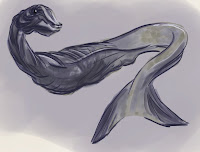Tsuchinoko
Tsuchinoko are described as being between 30 and 80 centimeters in length, similar in appearance to a snake, but with a central girth that is much wider than its head or tail, and as having fangs and venom similar to that of a viper.[1] Some accounts also describe the tsuchinoko as being able to jump up to a meter in distance.
According to legend, some tsuchinoko have the ability to speak and a propensity for lying, as well as a taste for alcohol. Legend also records that it will sometimes swallow its own tail so that it can roll like a hoop, similar to the mythical Hoop snake.
Tsuchinoko is a mythical creature from Japanese folklore. It is a small, serpentine creature that is said to have a round body, short legs, and a tail. It is said to have the ability to move quickly and smoothly, and it is said to have a variety of abilities, including the ability to speak, to change its shape, and to move silently.
The Tsuchinoko is typically depicted as a small, snake-like creature that is around 60 cm (2 feet) long and around 10 cm (4 inches) thick. It has a round body, short legs, and a tail. It's said to be able to move quickly and smoothly and it's said to have a variety of abilities, including the ability to speak, to change its shape, and to move silently.
It is said that the Tsuchinoko can be found in the mountains, forests, and caves of Japan, and it's believed that it's a nocturnal animal. It's said that it's a mischievous creature that likes to play pranks on people, but it's not considered as harmful.
The Tsuchinoko is a popular creature in Japanese folklore and is often featured in stories, films, and TV shows. It is considered as a symbol of mystery and is associated with the unknown.
It's worth noting that it's not a real creature, it's a mythical one, and it's part of the Japanese culture and tradition. Its depiction varies from region to region and from storyteller to storyteller.

Tsuchinoko is real
ReplyDeleteSnake Eater...
Delete